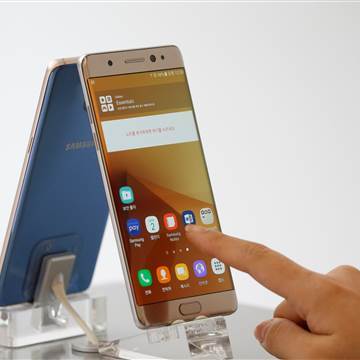Half a million Galaxy Note 7 smartphones without potentially explosive batteries will be available for exchange across the United States beginning Wednesday, Samsung said Tuesday.
Samsung said Sept. 2 that it was recalling all 2.5 million Note 7s worldwide and would replace them free because of a manufacturing defect that could cause their rechargeable lithium-ion batteries to catch fire or even explode while charging.
CNBC: After the Note 7, Here Are 10 of the Biggest Tech Recalls Ever
But the company couldn’t implement a formal exchange policy for Note 7 owners in the United States until the Consumer Product Safety Commission announced a recall — which it didn’t do until last week.
Samsung said Tuesday that 25 percent of the affected phones in the United States have already been exchanged voluntarily since the company’s Sept. 2 announcement. The initial delivery arriving in stores Wednesday means about three-quarters of U.S. Note 7 owners will have exchanged their Note 7s or can do so immediately.
Owners who disregard the recall will get a software update that will pop up a reminder every time their phones are powered up or plugged in to charge, said Samsung, which said owners will be able to tell that they’ve got a new, safe phone because the color of the battery icon in their status bars — the information bar at the top of the screen — will turn green.
Related: What to Do If You Have a Recalled Samsung Galaxy Note 7
In the absence of the formal recall, Samsung had tried a variety of ways to get owners to stop using the flammable phones.
The company said last week that it would begin downloading a separate software update that wouldn’t let Note 7 batteries charge past 60 percent, cutting the phone’s battery life almost in half. At the same time, it urged users to turn off their Note 7s immediately and get them replaced — without clarifying how it could push the update to a phone if you’ve followed its advice and turned the phone off.


It’s a murky but fast-moving story. Here’s what you need to know:
How many phones have gone bad?
It’s hard to say. In its recall last week, the CPSC update reported that there had been at least 92 incidents in the United States, including 26 reports of burns and 55 reports of property damage caused by fires in cars and a garage.
Those numbers encompass only formal reports made to the federal government. Other reports of similar incidents have continued since then — like a suspected Note 7-caused house fire in South Carolina and the Jeep that was burned out in St. Petersburg, Fla., after the owner left his Note 7 on its charger while he unloaded some shopping.
“Not the barbecue I wanted on my day off,” the owner said.
What went wrong?
The battery in the Note 7 is a rechargeable lithium-ion unit in which charged atoms, or ions, of lithium move back and forth from the negative end of the battery to the positive end. The ions reverse toward the positive side when the battery’s on its charging cord.
What happened with the Note 7 batteries — and only the Note 7 batteries, according to Samsung — is that during the manufacturing process, a fault got through that makes it possible for the positive and negative ends of the battery (called anodes) to come into contact with each other.
“If negative and positive sides of a battery combine, either due to a material failure or due to [a] defect in the cell assembly, it leads to short circuiting of the battery,” said Vibha Kalra, a professor of chemical and biological engineering at Drexel University in Philadelphia.
And when that happens, you can get “overheating, and possible fire [or] explosion,” Kalra said on Drexel’s blog.
How hot can the phones get? Literally too hot to handle.
“A lady came in yesterday, and she couldn’t even touch it when it was charging — like, physically is not possible to touch it,” Tyler Childress, owner of The Cell Phone Guy in Sioux Falls, S.D., told NBC station KDLT. “She had to unplug it and let it cool down first.”
What’s being done?
Other countries, like Canada, issued formal recalls weeks ago. In the United States, the Federal Aviation Administration, several airlines, New York’s Metropolitan Transit Authority and New Jersey Transit have all asked passengers to keep their Note 7s turned off on passenger planes, trains and buses.
…


![[Video] Samsung Teases ‘AI Home Experience’ Ahead of](https://loginby.com/itnews/wp-content/uploads/2025/03/1742985292_Video-Samsung-Teases-‘AI-Home-Experience’-Ahead-of-238x178.jpg)




